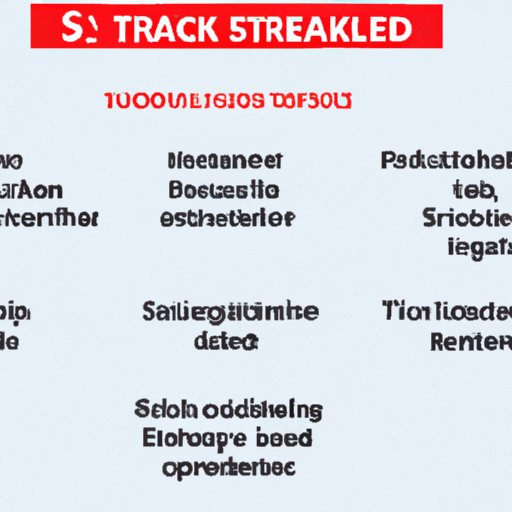Introduction
A stroke is a medical emergency that occurs when blood flow to the brain is disrupted, resulting in cell death due to lack of oxygen and nutrients. Depending on the type of stroke, the effects can range from mild to severe, and can even be fatal. It is important to recognize the signs and symptoms of a stroke and seek help immediately for the best possible outcome.
The most common type of stroke is an ischemic stroke, which accounts for approximately 87% of all strokes. In this article, we will explore what an ischemic stroke is, its risk factors, signs and symptoms, treatments, and prevention.

Identifying the Most Common Type of Stroke
An ischemic stroke occurs when a blood vessel carrying oxygen and nutrients to the brain becomes blocked by a clot or plaque deposit. This blockage reduces or stops the flow of blood to the brain, depriving it of oxygen and nutrients. Without oxygen, brain cells begin to die within minutes.
Risk factors associated with ischemic stroke include age, high blood pressure, smoking, diabetes, high cholesterol, obesity, physical inactivity, and family history. People who are older than 55, have high blood pressure, smoke, or have diabetes are at an increased risk for an ischemic stroke.

A Look at the Most Common Form of Stroke
The signs and symptoms of an ischemic stroke may vary depending on the area of the brain affected, but generally include sudden numbness or weakness in the face, arm, or leg, especially on one side of the body; confusion; trouble speaking or understanding speech; trouble seeing in one or both eyes; difficulty walking; dizziness; and a severe headache.
Treatment for an ischemic stroke may involve medications such as aspirin, anticoagulants, or thrombolytics. Surgery may also be necessary to remove the clot or plaque deposit, restore blood flow, and prevent further damage. The sooner treatment is sought, the better the outcome is likely to be.
Exploring the Most Prevalent Kind of Stroke
The cause of an ischemic stroke may be due to a buildup of plaque deposits in the arteries, a blood clot that has traveled from another part of the body, or a decrease in blood flow caused by a narrowing of the arteries. Other causes include damage to the heart, infection, or trauma.
Prevention of an ischemic stroke involves lifestyle changes such as quitting smoking, eating a healthy diet, exercising regularly, maintaining a healthy weight, and controlling blood pressure and cholesterol levels. Additionally, people at risk for stroke should take medications as prescribed by their doctor.
Common Types of Stroke: What You Need to Know
Ischemic stroke is the most common type of stroke, accounting for 87% of all strokes. However, other types of stroke exist, such as hemorrhagic stroke, which occurs when a weakened blood vessel ruptures and bleeds into the brain. Transient ischemic attack (TIA) is another type of stroke, which is a temporary blockage of a blood vessel in the brain.
The main difference between ischemic and other types of stroke is that ischemic stroke is caused by a blockage of a blood vessel, while other types of stroke are caused by bleeding in the brain. Treatment for each type of stroke is different, and it is important to recognize the signs and symptoms of each type of stroke so that appropriate treatment can be sought.

Understanding the Most Common Type of Stroke
Ischemic stroke is the most common type of stroke, accounting for 87% of all strokes. It is caused by a blockage of a blood vessel, resulting in a lack of oxygen and nutrients to the brain. Risk factors include age, high blood pressure, smoking, diabetes, high cholesterol, obesity, physical inactivity, and family history. Signs and symptoms of ischemic stroke include sudden numbness or weakness in the face, arm, or leg, confusion, trouble speaking or understanding speech, trouble seeing in one or both eyes, difficulty walking, dizziness, and a severe headache.
Treatment for an ischemic stroke may involve medications or surgery, and prevention includes making lifestyle changes such as quitting smoking, eating a healthy diet, exercising regularly, maintaining a healthy weight, and controlling blood pressure and cholesterol levels. It is important to recognize the signs and symptoms of ischemic stroke and seek help immediately for the best possible outcome.
Conclusion
Ischemic stroke is the most common type of stroke, accounting for 87% of all strokes. It is important to recognize the signs and symptoms of ischemic stroke and seek help immediately. Understanding the risk factors, signs and symptoms, causes, treatments, and prevention of ischemic stroke can help people reduce their risk and increase their chances of a good outcome.
Resources for Further Information
National Institute of Neurological Disorders and Stroke: https://www.ninds.nih.gov/Disorders/Patient-Caregiver-Education/Hope-Through-Research/Stroke-Hope-Through-Research
Mayo Clinic: https://www.mayoclinic.org/diseases-conditions/stroke/symptoms-causes/syc-20350113
Centers for Disease Control and Prevention: https://www.cdc.gov/stroke/index.


